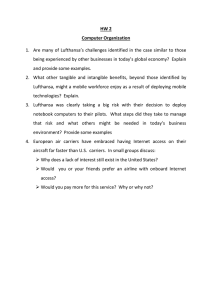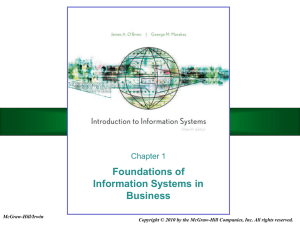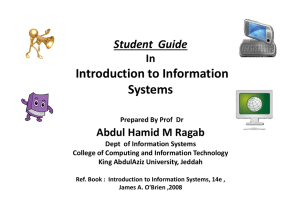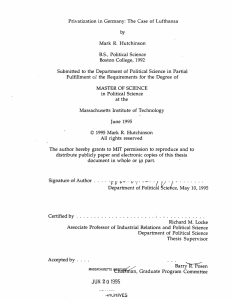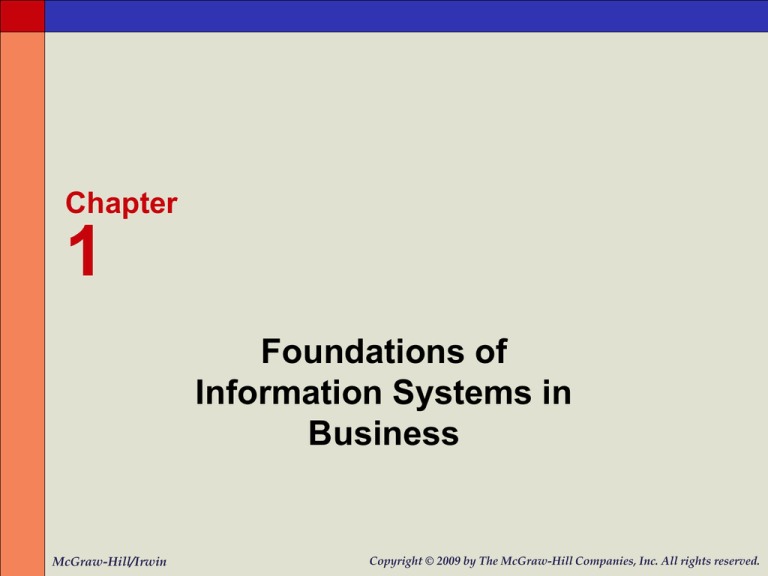
Chapter
1
Foundations of
Information Systems in
Business
McGraw-Hill/Irwin
Copyright © 2009 by The McGraw-Hill Companies, Inc. All rights reserved.
Learning Objectives
1. Understand the concept of a system
and how it relates to information
systems
2. Explain why knowledge of
information systems is important for
business professionals
– Identify five areas of information
systems knowledge needed
1-2
Learning Objectives
3. Give examples to illustrate how business
applications of information systems can
support a firm’s
–
–
–
Business processes
Managerial decision making
Strategies for competitive advantage
4. Provide examples of information systems
from your experiences with business
organizations in the real world
1-3
Learning Objectives
5. Identify challenges that a business
manager might face in managing the
successful, ethical development and
use of information technology
6. Provide examples of the components
of real world information systems
7. Become familiar with the myriad of
career opportunities in information
systems
1-4
Case 1: Sew What? Inc.
• Sew What? provides custom theatrical draperies and
fabrics for stages, concerts, fashion shows, and
special events worldwide.
• After launching the company web site, they acquired
clients from all over the world and their revenue has
been growing more than 45% per year.
• Sew What? runs most of its business with Intuit’s
Quick-Books Enterprise Solutions & Dell PowerEdge
servers.
• Recently, the National Federation of Independent
Businesses (NFIB) and Dell Inc. presented Sew
What? “Small Business Excellence Award” in
recognition of its innovative use of technology to
improve its customers’ experience.
1-5
Case Study Questions
1. How do information technologies
contribute to the business success
of Sew What? Inc.? Give several
examples from the case regarding
the business value of information
technology that demonstrate this
conclusion.
1-6
Case Study Questions
2. If you were a management
consultant to Sew What? Inc., what
would you advise Megan Duckett to
do at this point to be even more
successful in her business? What
role would information technology
play in your proposals? Provide
several specific recommendations.
1-7
Case Study Questions
3. How could the use of information
technology help a small business
you know be more successful?
Provide several examples to support
your answer.
1-8
Foundation Concepts
• Why study information systems and
information technology?
– Vital component of successful
businesses
– Helps businesses expand and compete
– Improves efficiency and effectiveness of
business processes
– Facilitates managerial decision making
and workgroup collaboration
1-9
What is an Information System?
• An organized combination of…
–
–
–
–
–
People
Hardware and software
Communication networks
Data resources
Policies and procedures
• This system…
– Stores, retrieves, transforms, and disseminates
information in an organization
1-10
Information Technologies
• Information Systems
– All the components and resources
necessary to deliver information and
functions to the organization
– Could be paper based
• Information Technologies
– Hardware, software, networking, data
management
• Our focus will be on computer-based
information systems (CBIS)
1-11
What Should Business Professionals Know?
1-12
Fundamental Roles of IS in Business
1-13
Trends in Information Systems
1-14
What is E-Business?
• Using Internet technologies to
empower…
– Business processes
– Electronic commerce
– Collaboration within a company
– Collaboration with customers, suppliers,
and other business stakeholders
• In essence, an online exchange of
value
1-15
How E-Business is Being Used
1-16
E-Business Use
• Reengineering
– Internal business processes
• Enterprise collaboration systems
– Support communications, coordination
and coordination among teams and
work groups
• Electronic commerce
– Buying, selling, marketing, and servicing
of products and services over networks
1-17
Types of Information Systems
• Operations Support Systems
–
–
–
–
Efficiently process business transactions
Control industrial processes
Support communication and collaboration
Update corporate databases
• Management Support Systems
– Provide information as reports and displays
– Give direct computer support to managers
during decision-making
1-18
Purposes of Information Systems
1-19
Operations Support Systems
• What do they do?
– Efficiently process business
transactions
– Control industrial processes
– Support communications and
collaboration
– Update corporate databases
1-20
Types of Operations Support Systems
• Transaction Processing Systems
– Record and process business transactions
– Examples: sales processing, inventory
systems, accounting systems
• Process Control Systems
– Monitor and control physical processes
– Example: using sensors to monitor chemical
processes in a petroleum refinery
• Enterprise Collaboration Systems
– Enhance team and workgroup communication
– Examples: email, video conferencing
1-21
Two Ways to Process Transactions
• Batch Processing
– Accumulate transactions over time and
process periodically
– Example: a bank processes all checks
received in a batch at night
• Online Processing
– Process transactions immediately
– Example: a bank processes an ATM
withdrawal immediately
1-22
Management Support Systems
• What do they do?
– Provide information and support for
effective decision making by managers
• Management information systems
• Decision support systems
• Executive information systems
1-23
Types of Management Support Systems
• Management Information Systems (MIS)
– Reports and displays
– Example: daily sales analysis reports
• Decision Support Systems (DSS)
– Interactive and ad hoc support
– Example: a what-if analysis to determine
where to spend advertising dollars
• Executive Information Systems (EIS)
– Critical information for executives and
managers
– Example: easy access to actions of
competitors
1-24
Other Information Systems
• Expert Systems
– Provide expert advice
– Example: credit application advisor
• Knowledge Management Systems
– Support creation, organization, and
dissemination of business knowledge
throughout company
– Example: intranet access to best
business practices
1-25
Other Information Systems
• Strategic Information Systems
– Help get a strategic advantage over
customer
– Examples: shipment tracking, ecommerce Web systems
• Functional Business Systems
– Focus on operational and managerial
applications of basic business functions
– Examples: accounting, finance, or
marketing
1-26
IT Challenges and Opportunities
1-27
Measuring IT Success
• Efficiency
– Minimize cost, time, and use of
information resources
• Effectiveness
– Support business strategies
– Enable business processes
– Enhance organizational structure and
culture
– Increase customer and business value
1-28
Developing IS Solutions
1-29
Challenges and Ethics of IT
• Application of IT
– Customer relationship management
– Human resources management
– Business intelligence systems
• Potential Harm
– Infringements on privacy
– Inaccurate information
– Collusion
1-30
Challenges and Ethics of IT
• Potential Risks
– Consumer boycotts
– Work stoppages
– Government intervention
• Possible Responses
– Codes of ethics
– Incentives
– Certification
1-31
Ethical Responsibilities
• What uses of IT might be considered
improper or harmful to other
individuals or society?
• What is the proper business use of
the Internet
or a company’s IT resources?
• How can you protect yourself from
computer crime?
1-32
IT Careers
• Economic downturns have affected all job
sectors, including IT
• Rising labor costs are pushing jobs to
India,
the Middle East, and Asia-Pacific countries
• However, IT employment opportunities are
strong, with new jobs emerging daily
• Shortages of IT personnel are frequent
• The long-term job outlook is positive and
exciting
1-33
IT Careers
1-34
IT Careers
• Job increases will be driven by…
– Rapid growth in computer system design and
related services
– The need to backfill positions
– Information sharing and client/server
environments
– The need for those with problem-solving skills
– Falling hardware and software prices, which
will fuel expanded computerization of
operations
1-35
The IS Function
• The IS function is…
– A major functional area of business
– An important contributor to operational
efficiency, employee productivity, morale,
customer service and satisfaction
– A major source of information and support for
decision making
– A vital ingredient in developing competitive
products and services in the global marketplace
– A dynamic and challenging career opportunity
– A key component of today’s networked business
1-36
System Concepts: A Foundation
• System concepts help us understand…
– Technology: hardware, software, data
management, telecommunications networks
– Applications: to support inter-connected
information systems
– Development: developing ways to use
information technology includes designing the
basic components of information systems
– Management: emphasizes the quality, strategic
business value, and security of an organization’s
information systems
1-37
Real World Case: JetBlue and the Veterans
Administration
• Good IT processes are as important as hardware
and software when it comes to creating business
value through the use of technology.
• Even seemingly smaller and less critical processes
can have ramifications of a large magnitude in the
interconnected world in which we live.
• The information system, which was developed by
JetBlue in 24 hours and implemented in the middle
of crisis in 2007, has now been implemented as a
full-time system in the company.
• At Veterans Administration an unscheduled system
failure took down key applications in 17 (VA)
medical facilities for a day
1-38
Case Study Questions
1. Eric Brinker of JetBlue noted that the
database developed during the crisis
had not been needed before since
the company had never experienced
a meltdown. What are the risks and
benefits associated with this
approach to IT planning? Provide
some examples of each.
1-39
Case Study Questions
2. With hindsight, we now know that
the decision made by Eric Raffin of
the VA not to fail over to the Denver
site was the correct one. However, it
involved failing to follow established
backup procedures. With the
information he had at the time, what
other alternatives could he have
considered? Develop at least two of
them.
1-40
Case Study Questions
3. A small, undocumented change
resulted in the collapse of the VA
system, largely because of the high
interrelationship between its
applications. What is the positive
side of this high degree of
interconnection, and how does this
benefit patients? Provide examples
from the case to justify your answer.
1-41
What is a System?
• A system is…
– A set of interrelated components
– With a clearly defined boundary
– Working together
– To achieve a common set of objectives
– By accepting inputs and producing
outputs
– In an organized transformation process
1-42
Basic Functions of a System
• Input
– Capturing and assembling elements that
enter the system to be processed
• Processing
– Transformation process that converts
input into output
• Output
– Transferring transformed elements to
their ultimate destination
1-43
Cybernetic System
• All systems have input, processing, and
output
• A cybernetic system, a self-monitoring,
self-regulating system, adds feedback and
control:
– Feedback is data about the performance of a
system
– Control involves monitoring and evaluating
feedback to determine whether a system is
moving toward the achievement of its goal
1-44
A Cybernetic System
1-45
A Business as a System
1-46
Other System Characteristics
• If a system is one of the components
of a larger system, it is a subsystem
– The larger system is an environment
• Several systems may share the same
environment
– Some may be connected via a shared
boundary, or interface
• Types of systems…
– Open
– Adaptive
1-47
Components of an IS
1-48
Information System Resources
• People Resources
– Specialists
– End users
• Hardware Resources
– Machines
– Media
• Software Resources
– Programs
– Procedures
1-49
Information System Resources
• Data Resources
– Product descriptions, customer records,
employee files, inventory databases
• Network Resources
– Communications media, communications
processors, network access and control
software
• Information Resources
– Management reports and business documents
using text and graphics displays, audio
responses, and paper forms
1-50
Data Versus Information
• Data are raw facts about physical
phenomena or business transactions
• Information is data that has been
converted into meaningful and useful
context for end users
• Examples:
– Sales data is names, quantities, and dollar
amounts
– Sales information is amount of sales by
product type, sales territory, or salesperson
1-51
IS Activities
• Input of data resources
– Data entry activities
• Processing of data into information
– Calculations, comparisons, sorting, and so on
• Output of information products
– Messages, reports, forms, graphic images
• Storage of data resources
– Data elements and databases
• Control of system performance
– Monitoring and evaluating feedback
1-52
Recognizing Information Systems
• Business professionals should be
able to look at an information system
and identify…
– The people, hardware, software, data,
and network resources they use
– The type of information products they
produce
– The way they perform input, processing,
output, storage, and control activities
1-53
Case 3: Heidelberg, Honeywell, and Eaton
• Today, it is not be enough for a company to
offer services but it will have to provide
“smart services.”
• To provide smart services, companies must
use information technology to build “smart
products.”
• Smart products can detect that a part is
approaching failure and alert users, thus
giving the company opportunity to provide
maintenance services and enjoy the
resulting benefits.
1-54
Case 3: Heidelberg, Honeywell, and Eaton
• Heidelberg developed the technology to monitor
its equipment remotely, using built-in sensors,
networking microprocessors, and other
information technologies.
• With such smart services, Heidelberg now offers
total support of its products.
• Eaton corporation has developed a product called
Home Heartbeat which monitors the status of
various home systems and alerts the homeowner
when something is wrong.
1-55
Case Study Questions
1. Why should manufacturing companies build smart
products and provide smart services? What business
benefits can they gain? Provide several examples
beyond those discussed in this case.
2. What information technologies are used by the
companies in this case to build smart products and
provide smart services? What other IT components
might be used? Give examples of the capabilities they
would provide.
3. What are some limitations of a smart products and
smart services strategy? Give several examples of
challenges that a business might encounter, and
explain how it might overcome them.
1-56
Case 4: Lufthansa
• In 2001, Lufthansa launched the “Lufthansa Mobile
Initiative,” which aimed to provide all pilots with
notebook computers.
• It helps 3,500 highly mobile airline pilots plugged into
the corporate infrastructure, that informs them about
schedules, weather events, and other facts that affect
their jobs throughout the world.
• The Lufthansa Mobile Initiative is yielding significant
productivity and efficiency improvements, while
keeping costs manageable.
• Pilots use their notebook computers for computerbased training whether they are learning about new
aircraft or things like specific hydraulic systems.
1-57
Case Questions
1. Are many of Lufthansa’s challenges identified in
the case similar to those being experienced by
other businesses in today’s global economy?
Explain and provide some examples.
2. What other tangible and intangible benefits,
beyond those identified by Lufthansa, might a
mobile workforce enjoy as a result of deploying
mobile technologies? Explain.
3. Lufthansa was clearly taking a big risk with their
decision to deploy notebook computers to their
pilots. What steps did they take to manage that
risk, and what others might be needed in today’s
business environment? Provide some examples.
1-58

